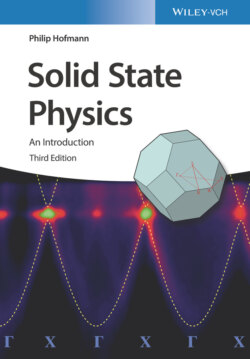Читать книгу Solid State Physics - Philip Hofmann - Страница 23
1.3.1.3 General Diffraction Theory
ОглавлениеThe Bragg theory for X‐ray diffraction is useful for extracting the distances between lattice planes in a crystal, but it has its limitations. Most importantly, it does not provide any information on what the lattice actually consists of, that is, the basis. Also, the fact that the X‐rays are described as being reflected by planes is physically somewhat obscure. In the following, we will therefore discuss a more general description of X‐ray diffraction that goes back to M. von Laue.
The physical process leading to X‐ray scattering is that the electromagnetic field of the X‐rays forces the electrons in the material to oscillate with the same frequency as that of the field. The oscillating electrons then emit new X‐rays that give rise to an interference pattern. For the following discussion, however, it is merely important that something scatters the X‐rays, not what it is.
It is highly beneficial to use the complex notation for describing the electromagnetic X‐ray waves. For the electric field, a general plane wave can be written as
(1.4)
The wave vector points in the direction of the wave propagation with a length of , where is the wavelength. The convention is that the physical electric field is obtained as the real part of the complex field and the intensity of the wave is obtained as
(1.5)
Consider now the situation depicted in Figure 1.10. The source of the X‐rays is far away from the sample at the position so that the X‐ray wave at the sample can be described as a plane wave. The electric field at a point in the crystal at time can be written as
(1.6)
Before we proceed, we can drop the absolute amplitude from this expression because we are only interested in relative phase changes. The field at point is then
Figure 1.10 Illustration of X‐ray scattering from a sample. The source and detector for the X‐rays are placed at and , respectively. Both are very far away from the sample.
A small volume element located at will give rise to scattered waves in all directions. The direction we are interested in is that towards the detector, which we assume to be placed at position , in the direction of a second wave vector . We assume that the amplitude of the wave scattered in this direction will be proportional to the incoming field from Eq. (1.7) and to a factor describing the scattering probability and scattering phase. We already know that the scattering of X‐rays proceeds via the electrons in the material, and for our purpose, we can view as the electron concentration in the solid. For the field at the detector, we obtain
(1.8)
Again, we have assumed that the detector is very far away from the sample so that the scattered wave at the detector can be written as a plane wave. Inserting Eq. (1.7) gives the field at the detector as
(1.9)
We drop the first factor that does not contain and will thus not play a role for the interference of X‐rays emitted from different positions in the sample. The total wave field at the detector can finally be calculated by integrating over the entire volume of the crystal. As the detector is far away from the sample, the wave vector is essentially the same for all points in the sample. The result is therefore
(1.10)
In most cases, it will only be possible to measure the intensity of the X‐rays and not the field amplitude. This intensity is given by
where we have introduced the so‐called scattering vector , which is just the difference of the outgoing and incoming wave vectors. Note that although the direction of the wave vector for the scattered waves is different from that of the incoming wave , their lengths are the same because we consider elastic scattering only.
Equation 1.11 is our final result. It relates the measured intensity to the electron concentration in the sample. Except for very light elements, most of the electrons are located close to the ion cores and the electron concentration that scatters the X‐rays is essentially identical to the geometrical arrangement of the atomic cores. Hence, Eq. (1.11) can be used for the desired structure determination. To this end, one could try to measure the intensity as a function of scattering vector and to infer the structure from the result. This is a formidable task, however. It is greatly simplified by the fact that the specimen under investigation is a crystal with a periodic lattice. In the following, we introduce the mathematical tools and concepts that are needed to exploit the crystalline structure in the analysis. The most important of these is the so‐called reciprocal lattice.
